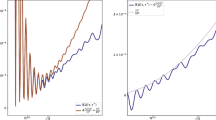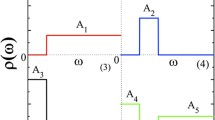Abstract
In the Redfield theory framework, we consider the problem of the vibrational dynamics in dissipative systems. We decompose the Hamiltonian of interaction of the observed system with a thermal bath into terms that are products of system transition operators and bath transition operators. Using the decomposition, we construct a correlation function matrix containing all the information about the interaction of the system with the bath and obtain a new operator form of the Redfield equation. We consider the procedure for factoring the interaction operator and constructing the correlation function matrix. Using the diagonalization of the obtained matrix, we give correlated dissipation operators, whose introduction simplifies the form of the Redfield equations. We show that for several problems in which fundamental transition frequencies can be chosen, this procedure significantly reduces the dimensionality of the dissipative dynamics problem.
Similar content being viewed by others
References
V. Sundström, Progr. Quantum Electron., 24, 187–238 (2000).
R. S. Knox, J. Photochem. Photobiol. B, 49, 81–88 (1999).
C. E. Crespo-Hernández, B. Cohen, P. M. Hare, and B. Kohler, Chem. Rev., 104, 1977–2020 (2004).
S. K. Pal and A. H. Zewail, Chem. Rev., 104, 2099–2124 (2004).
X. Hu, T. Ritz, A. Damjanovic, and K. Schulten, J. Phys. Chem. B, 101, 3854–3871 (1997).
W. Domcke and G. Stock, “Theory of ultrafast nonadiabatic excited-state processes and their spectroscopic detection in real time,” in: Advances in Chemical Physics (I. Prigogine and S. A. Rice, eds.), Vol. 100, Wiley, New York (1997), pp. 1–169.
A. G. Redfield, Adv. Magn. Res., 1, 1–32 (1965).
K. Blum, Density Matrix Theory and Applications: Physics of Atoms and Molecules, Plenum, New York (1981).
W. H. Louisell, Quantum Statistical Properties of Radiation, Wiley, New York (1973).
D. Egorova, A. Kühl, and W. Domcke, Chem. Phys., 268, 105–120 (2001).
D. Egorova and W. Domcke, J. Photochem. Photobiol. A, 166, 19–31 (2004).
A. Kühl and W. Domcke, J. Chem. Phys., 116, 263–274 (2002).
U. Weiss, Quantum Dissipative Systems (Ser. Modern Condensed Matter Phys., Vol. 10, 2nd ed.), World Scientific, Singapore (1999).
G. Lindblad, Comm. Math. Phys., 48, 119–130 (1976).
V. V. Eremin and I. O. Glebov, Theor. Math. Phys., 153, 1463–1475 (2007).
Author information
Authors and Affiliations
Corresponding author
Additional information
__________
Translated from Teoreticheskaya i Matematicheskaya Fizika, Vol. 161, No. 1, pp. 83–94, October, 2009.
Rights and permissions
About this article
Cite this article
Glebov, I.O., Eremin, V.V. A new form of the redfield equation for dissipative systems related to the matrix of correlation functions. Theor Math Phys 161, 1393–1402 (2009). https://doi.org/10.1007/s11232-009-0125-0
Received:
Revised:
Published:
Issue Date:
DOI: https://doi.org/10.1007/s11232-009-0125-0




